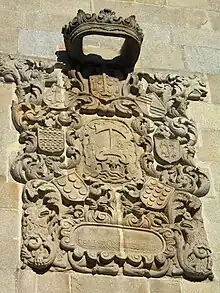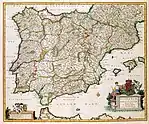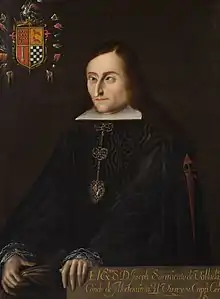
The Romay family (Spanish: Casa de Romay) is a Spanish aristocratic family that descends from 8th-century pre-Reconquista Galicia, in northern Spain. According to historians, the family descends from Román de Romae, Count of Monterroso and Santa María de Ortigueira, a natural grandson of King Alfonso I the Catholic.[1]
Origins
The indisputable line can be traced from the 13th-century records that coincide with the edification of the main family seat, the Palace of Cadro (Galician: Pazo do Cadro), in Marín, Pontevedra, Galicia. This is the oldest pazo in that region.
History
The Romay family is distinguished by its multiple alliances with noble families, such as Sarmiento de Valladares, Suárez de Deza, Saavedra, Mendoza, Montenegro, Ulloa, Varela, Fernández de Córdoba, Duque de Estrada, Osorio de Moscoso and Sotomayor.
Notable members:
- Don Jose Sarmiento Valladares Arines de Romay (1643-1708), 1st Duke of Atrisco, 40th Viceroy of New Spain
- Don Juan de Romay, 18th Count of Monterroso, Lord of Cadro.
- Doña Antonia de Romay-Sotomayor y Varela-Ulloa, Countess of Villanueva de San Bernardo
- Doña Josefa de Romay y de España, Grandee of Spain, Baroness of Casa do Ria[2]
- Don Alonso Enriquez Sarmiento Valladares y Romay (1700-1757) IV Marquess of Valladares, III Viscount Meira[2]
- Doña Juana de la Torre de Romay-Sotomayor, II Marquesa de Bendaña
- Ramón Romay y Ximenez de Cisneros (1764 -1849), Captain General of the Spanish Navy and Director General of the same.
- José Alfonso Correa Cortés de Mendoza Ozores de Sotomayor y Romay, II count of Villanueva de San Bernardo, II viscount of Pegullal, etc.
- Don Teodosio de Romay, Count of Monterroso, Lord of Cadro[3]
- Leonor Romay Yáñez-Sotomayor, Countess de la Torre Vilariño
- José Manuel Romay y Beccaria, Spanish politician.
- Tomas Romay y Chacon, doctor of the Royal Chamber and Knight Commander of the Order of Isabel la Católica.
- Don Diego de Romay, architect.[4]
- Doña María Romay Torrado, XVI Viscountess of La Pedreira
- Don Enrique de Romay y Piña, XLV Lord of Cadro and Monterroso.
- Don Ricardo de Romay y Wisbrun Chacon,[3] married in Mexico City in 1948 with Doña Ofelia Hernandez-Chazaro Lemus de Mier, a great-granddaughter of the Counts of Heras Soto.[5] They had six children, among them Don Ricardo de Romay y Hernandez-Chazaro (1951-), who succeeded his father as head of the family in 2018.[3]
Dominion and influence
_c._1697-1701.jpg.webp)
The best preserved registered settlement of the Romay family can be found in the archives of the 13th-century Pazo of Cadro, the ancestral family seat in Marin, Pontevedra, where they would have exercised civil and criminal jurisdiction.[6] Marín's council archives document that “the House of Romay can be traced back to the beginning of The Reconquista”, in other words before the year 711.[7]
Although heads of the family are often informally referred to by their ancestral titles, those honorifics are unofficial as Mexico is now a republic with all royal and noble titles being legally abolished by article 12 of The Federal Constitution of 1857.
One of their principal properties in Mexico was the Hacienda San Juan Bautista Tabi, in Yucatan, Mexico. It now belongs to the state.
Arms

The first record of the Romay heraldic arms can be found in the fortress of Tras do Rio, in Frieiro, in the district of San Julian de Romay, Portas. As far as the armoury is concerned, the most ancient depiction dictates: «Coronet: That of a Lord. Crest: in a silver field a Lion Rampant Gules, under whose claws two Fig Leaves Saber and an ‘M' Gules under a Comital Coronet Or”.[8]
See also
References
- ↑ Dinastía Cánttabra (Linea 1a)
- 1 2 Registro de los Grandes de España
- 1 2 3 E. Pardo de Guevara, La memoria genealógica y el orgullo de linaje en un instrumento de 1509, “Nobiltà”, 70 (2006), pp. 103-127.
- ↑ María Dolores Vila Jato, "El patrimonio histórico de la Universidad de Santiago de Compostela", USC p. 44
- ↑ La dinastia dei Grimaldi: settecento anni di storia e leggenda del Principato di Monaco, Enrica Roddolo, Publisher Piemme (1997) Tomo 1 pagina 146-48
- ↑ Crespo, José Santiago. Blasones y Linajes de Galicia. Ediciones Boreal. La Coruña, 1984. Tomo IV, página 213
- ↑ Alfredo Perez Lara, El pazo y la historia de Galicia, Heraldo de Pontevedra, 90 (2003), pp. 73
- ↑ Valero de Bernabé Luis y Eugenio, Martín de. Simbología y diseño de la heráldica gentilicia galaica, Heráldica (2003) Madrid.
External links
- Diputación de la Grandeza de España (in Spanish)
- Registro de los Grandes de España:. (in Spanish)
- Dinastía de Cantabia (1a Línea) (in Spanish)
- Romay en Betanzos (in Spanish)
| History of Spain |
|---|
 |
| Timeline |

